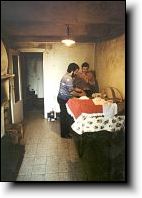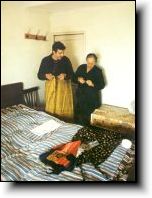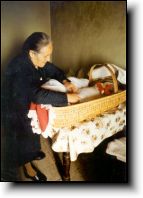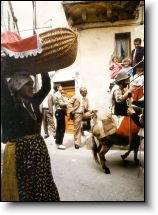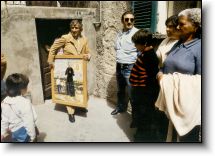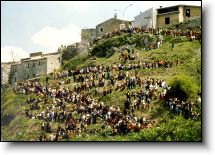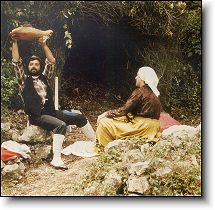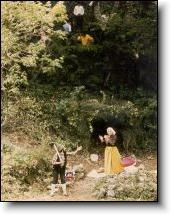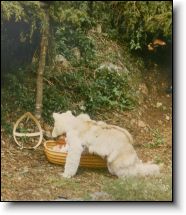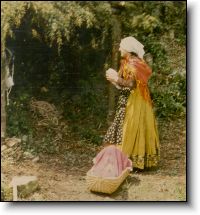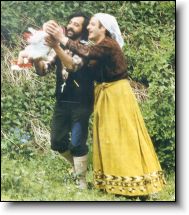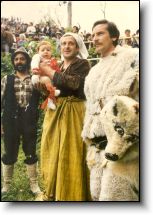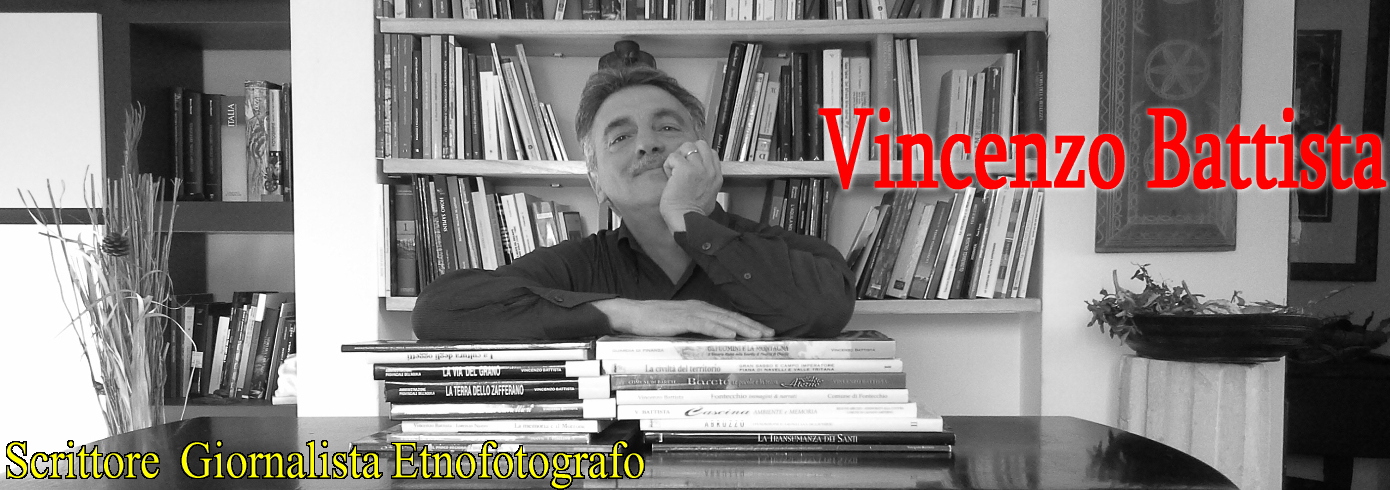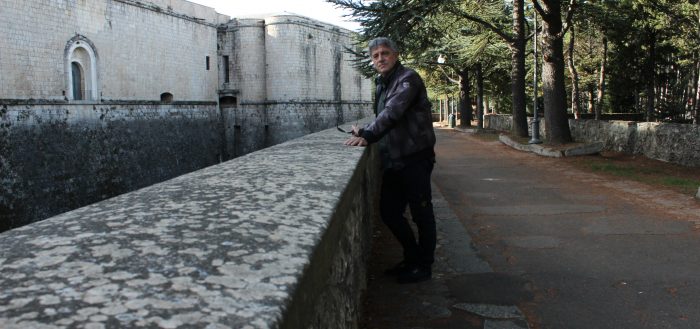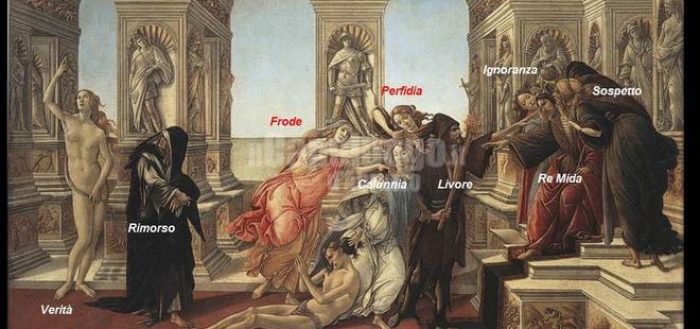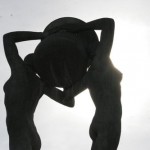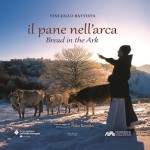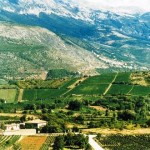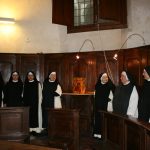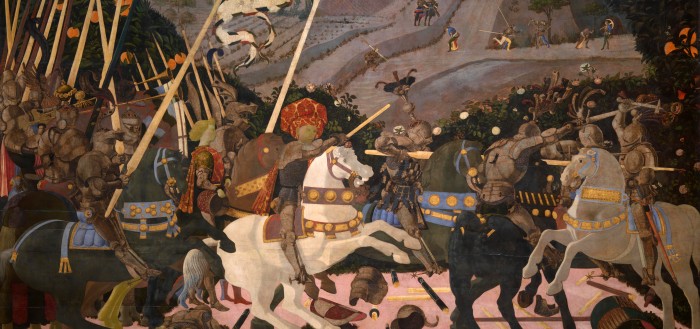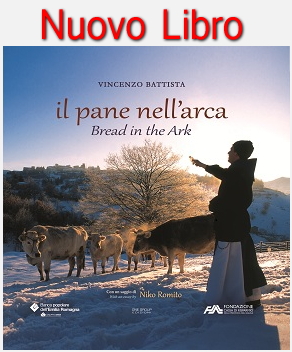Testo e fotografia di Vincenzo Battista.
I due uomini di Pretoro, che impersonano il boscaiolo e la moglie nella pantomima di “San Domenico e il lupo” si preparano, assistiti da un’anziana donna, in una casa contadina del centro del paese. Il ruolo della donna sarà svolto da un uomo travestito, perché la sacra rappresentazione a Pretoro non prevede la figura della donna. La rappresentazione mimica dal titolo “San Domenico e il lupo” è tradizionalmente fissata la prima domenica del mese di maggio, a Pretoro, centro montano della provincia di Chieti, a 550 m. s.l.m. In un’altra casa del paese, intanto, la madre prepara il bambino, il primo nato del paese, che parteciperà alla Sacra Rappresentazione. Viene collocato in una culla tradizionale di vimini e poi portato nella casa della “famiglia dei boscaioli”. I figuranti escono dalla casa in corteo e attraversano le vie del paese fino al luogo della rappresentazione. Il quadro sacro, che rappresenta San Domenico, i due boscaioli e il lupo penitente, viene portato nel luogo scelto della rappresentazione e ubicato in un luogo visibile dalla folla dei fedeli e centrale rispetto agli avvenimenti che si succederanno. Il quadro dipinto testimonierà la presenza di San Domenico. La folla dei fedeli nella cavea dove avviene la rappresentazione di “San Domenico e il lupo”, alla periferia del paese, ha iniziato a prendere posizione. La rappresentazione mimica prende forma, inizia a comunicare… La famiglia di boscaioli davanti alla capanna consuma la colazione. Con ampi gesti i figuranti ne raccontano i momenti. Il boscaiolo saluta la moglie e si reca nel bosco a tagliare la legna. Il lupo, impersonato da un figurante coperto da una pelliccia esce dalla macchia, prende il bambino e si nasconde nella tana. Alla famiglia non resta altro che chiedere l’intercessione di San Domenico per la restituzione del figlio. Pregano il santo. Il santo interviene, il lupo restituisce il bambino: il miracolo è compiuto. La famiglia dei boscaioli esulta. La folla intervenuta applaude. I personaggi della Sacra Rappresentazione posano davanti ai fotografi. La folla, i fedeli, hanno attentamente “letto” tutti i passaggi della rappresentazione mimica e ne hanno tratto i buoni auspici, come accadeva in un passato recente, quando bisognava “liberare e pettinare” la natura, per lavorare senza timori nel bosco reso così immune, con l’aiuto di San Domenico, dai pregiudizi e dalle superstizioni che inevitabilmente colpivano il lupo, la diversità, “il male”. Ma il più osservato resta il bambino. Lui, penserà la comunità locale, crescerà protetto da San Domenico. E oggi, a distanza di molti anni, da quelle rilevazioni sul campo di una festa popolare, anch’io, mi domando del bambino, del suo futuro, al centro di una tradizione di ispirazione taumaturgica che sembra non avere tempo.
Traduzione Piera Badia.
The two men from Pretoro, who were chosen to play the roles of the woodcutter and his wife in the pantomime “St Dominick and the Wolf” get dressed, assisted by an elderly lady, in a peasant’s home in the village center. The female role is played by a disguised man, since the mystery play did not allow women to play that part.
The pantomime “St. Dominick and the Wolf” is traditionally held on the first Sunday in May in Pretoro, a fine mountain center in the province of Chieti at 550 meters above sea level. In another house, meanwhile, a mother prepares her child, the first born in the village for that year, who will also play a role in the Sacred Performance. The child is placed in a traditional cradle and then carried to the home of the “woodcutter’s family”.
The characters leave the home in a procession and walk through the village alleys to reach the performance site.
The holy picture representing St. Dominick, the woodcutter and his wife and the repentant wolf is carried to the site chosen for the performance and placed in a prominent position where everybody can see it, and in the center with respect to the scenes that will follow one another. The painting will be a sign of St. Dominick’s presence.
The crowd of the faithful start to take their seats in the valley just outside the village where the sacred performance of “St. Dominick and the Wolf” is due to begin.
The pantomime starts. The woodcutter and family have breakfast outside their hut. The characters perform with wide gestures so as to tell the story.
The woodcutter says goodbye to his wife and starts towards the wood to cut timber.
The wolf, played by an actor covered with an animal’s skin, gets out of the forest, takes the child and goes hiding into his den.
The family can do nothing but ask St. Dominick to help them and have the child back.
They pray the Saint.
The saint fulfils their prayers, the wolf gives the child: the miracle has taken place.
The woodcutter’s family rejoice. The crowd around cheer.
The characters of the Sacred Representation appear before the photographers. The crowd and the faithful have diligently “read” all the moments of the pantomime, drawing good omens from it, as it happened in a not too far away past, when nature had to be “freed and combed”, so as to be able to work without fear in the wood now safe thanks to the help of St. Dominick of the prejudice and superstitions always connected with the wolf, the “other”, in a word, the evil presence.
But the character that receives most attention is the child. The local people think he will grow under the protection of St. Dominick. And at the moment of writing, fifteen years after I witnessed and registered that event, I, too, wonder about the future of that child, who was unaware in the center of a timeless tradition exorcising evil and fear.
